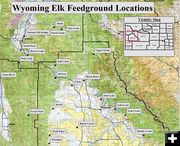Elk Feedgrounds
by Cat Urbigkit, Pinedale Online!
September 12, 2017
The Wyoming Game & Fish Department reports that the agency spent $2.3 million on its elk feedground program in Fiscal Year 2017, purchasing 6,000 to 9,000 tons of hay in Teton, Sublette, and Lincoln counties, at an average of $130 per ton delivered.
Elk are fed five to eight pounds of hay per elk daily by contract elk feeders, with the feeding season running an average of 120 days (from late November through mid-April, depending on local conditions).
According to the agency, 15,341 elk were fed on WG&F elk feedgrounds last winter, consuming 7,324 tons of hay. In addition to feeding on the state’s 21 feedgrounds (all located in western Wyoming), emergency feeding occurred in the Buffalo Valley, Star Valley, and Farson areas.
The agency documented wolf predation on elk at 14 of the state’s feed grounds.
Elk feeding allows the state wildlife agency to maintain stable elk populations regardless of winter range availability, keeps elk from moving onto private lands where damage situations occur, and prevents elk and cattle from commingling. The agency also maintains that feeding elk reduces elk/vehicle collisions in winter, as well as reduces competition on winter range with other big game species.
Elk feeding has received criticism because it concentrates elk into higher densities than would naturally occur on winter range, increasing the risk of disease transmission. In response to disease transmission concerns, the agency has implemented an action play to delay feeding as long as possible, and to end feeding in the spring as early as possible. Instead of feeding hay in single feedlines, feeders now practice low-density feeding methods that disperse elk while feeding.
The elk feeding program began during after the severe winter of 1908 in the Jackson Hole country, when numerous elk died of starvation. The next year, private individuals began feeding elk, and by 1912 the legislature allocated $5,000 to feed elk on what is now the National Elk Refuge.
Many feedgrounds were started in the 1940s to prevent damage to stored crops, and the present elk feeding system has been in place since the 1960s.
WG&F staff will present a more detailed look at the state’s elk feedground program at the WG&F Commission meeting later this month in Gillette.
|
